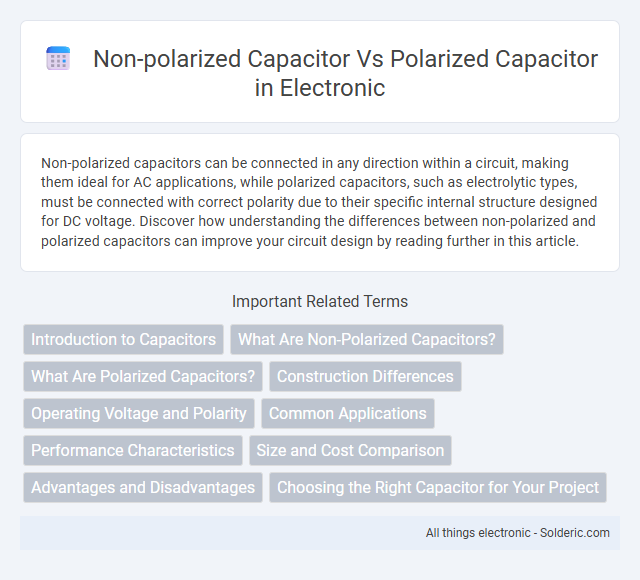Non-polarized capacitors can be connected in any direction within a circuit, making them ideal for AC applications, while polarized capacitors, such as electrolytic types, must be connected with correct polarity due to their specific internal structure designed for DC voltage. Discover how understanding the differences between non-polarized and polarized capacitors can improve your circuit design by reading further in this article.
Comparison Table
| Feature | Non-Polarized Capacitor | Polarized Capacitor |
|---|---|---|
| Polarity | No polarity (can be connected either way) | Has polarity (positive and negative terminals) |
| Common Types | Ceramic, Film, Mica capacitors | Electrolytic, Tantalum capacitors |
| Capacitance Range | Usually low capacitance (pF to uF) | Higher capacitance values (uF to thousands uF) |
| Voltage Ratings | Typically higher voltage ratings (up to several kV) | Lower voltage ratings (usually up to ~100V) |
| Application | AC circuits, signal coupling, high-frequency applications | DC power supply filtering, bulk energy storage |
| Equivalent Series Resistance (ESR) | Lower ESR | Higher ESR |
| Physical Size | Smaller for lower capacitance | Larger for similar capacitance |
| Temperature Stability | Better stability | Less stable, affected by temperature and aging |
Introduction to Capacitors
Capacitors store and release electrical energy, classified mainly into non-polarized and polarized types based on their structure and application. Non-polarized capacitors, such as ceramic and film capacitors, can operate with AC signals and in circuits where polarity changes, while polarized capacitors, like electrolytic capacitors, are designed for DC circuits with a specific polarity. Understanding the differences helps you select the right capacitor for your circuit's voltage, frequency, and stability requirements.
What Are Non-Polarized Capacitors?
Non-polarized capacitors are electronic components that can be connected in any direction within a circuit, unlike polarized capacitors which require correct polarity for proper operation. These capacitors are typically used in AC signal applications, filtering, and coupling due to their ability to handle bidirectional current flow without damage. Common types of non-polarized capacitors include ceramic, film, and mica capacitors, known for their stability and reliability across various frequencies.
What Are Polarized Capacitors?
Polarized capacitors, such as electrolytic and tantalum types, have distinct positive and negative terminals and must be connected correctly within a circuit to function properly. These capacitors offer higher capacitance values, making them suitable for applications like power supply filtering and audio equipment, where stable polarity is essential. Understanding the correct orientation is crucial to avoid damage or reduced performance in your electronic devices.
Construction Differences
Non-polarized capacitors feature symmetrical construction with identical electrodes and dielectric materials on both sides, enabling them to operate effectively regardless of voltage polarity. Polarized capacitors, such as electrolytic types, consist of asymmetrical layers including a metal anode, electrolyte as cathode, and a specially formed oxide dielectric, which mandates correct orientation for proper function. Understanding these construction differences helps you select the right capacitor type for AC or DC circuit applications.
Operating Voltage and Polarity
Non-polarized capacitors operate effectively under alternating current (AC) or direct current (DC) regardless of voltage direction, while polarized capacitors like electrolytic capacitors must be connected with correct polarity to avoid damage and performance degradation. Operating voltage ratings are critical for both types, but polarized capacitors typically have higher capacitance values and voltage limits suited for DC applications, whereas non-polarized capacitors are versatile in AC circuits with lower capacitance and voltage ratings. Your circuit's requirements for voltage and polarity dictate the appropriate capacitor choice to ensure optimal performance and reliability.
Common Applications
Non-polarized capacitors are commonly used in AC signal coupling, filtering, and timing circuits due to their ability to handle bidirectional voltage without damage. Polarized capacitors, such as electrolytic capacitors, are favored in DC power supply filtering and energy storage applications where high capacitance values are required. Non-polarized types excel in audio and RF circuits, while polarized capacitors are essential in power electronics and smoothing circuits.
Performance Characteristics
Non-polarized capacitors exhibit stable performance across AC and DC applications due to their symmetrical design and ability to handle bidirectional voltage, making them ideal for signal coupling and filtering. Polarized capacitors, such as electrolytic capacitors, provide higher capacitance values but are limited to DC circuits because reversing voltage polarity can cause failure, affecting reliability and lifespan. The dielectric material and construction of non-polarized capacitors enable lower equivalent series resistance (ESR) and better high-frequency response compared to polarized capacitors.
Size and Cost Comparison
Non-polarized capacitors are generally smaller and less expensive compared to polarized capacitors due to their simpler construction and lower voltage ratings. Polarized capacitors, such as electrolytic types, tend to be larger and more costly because they offer higher capacitance values and voltage tolerances. Your choice between these capacitor types will impact both the physical size and overall budget of your electronic design.
Advantages and Disadvantages
Non-polarized capacitors offer the advantage of being versatile in AC circuit applications since they can handle voltage in both directions without damage, typically exhibiting lower ESR (Equivalent Series Resistance) and longer lifespan in general use. Polarized capacitors, such as electrolytic types, provide higher capacitance values and are cost-effective for DC filtering but are limited by polarity constraints and shorter durability due to electrolyte degradation. The disadvantage of non-polarized capacitors lies in their usually lower capacitance per volume and higher cost compared to polarized capacitors, which are prone to failure if connected incorrectly or subjected to reverse voltage.
Choosing the Right Capacitor for Your Project
Non-polarized capacitors, such as ceramic or film types, are ideal for AC applications and circuits requiring reversible current flow, while polarized capacitors like electrolytic capacitors are suited for DC circuits with a defined polarity. When choosing the right capacitor for your project, consider voltage rating, capacitance value, frequency response, and whether the circuit will experience polarity reversal. Selecting the correct capacitor ensures optimal performance, stability, and longevity of your electronic design.
non-polarized capacitor vs polarized capacitor Infographic

 solderic.com
solderic.com